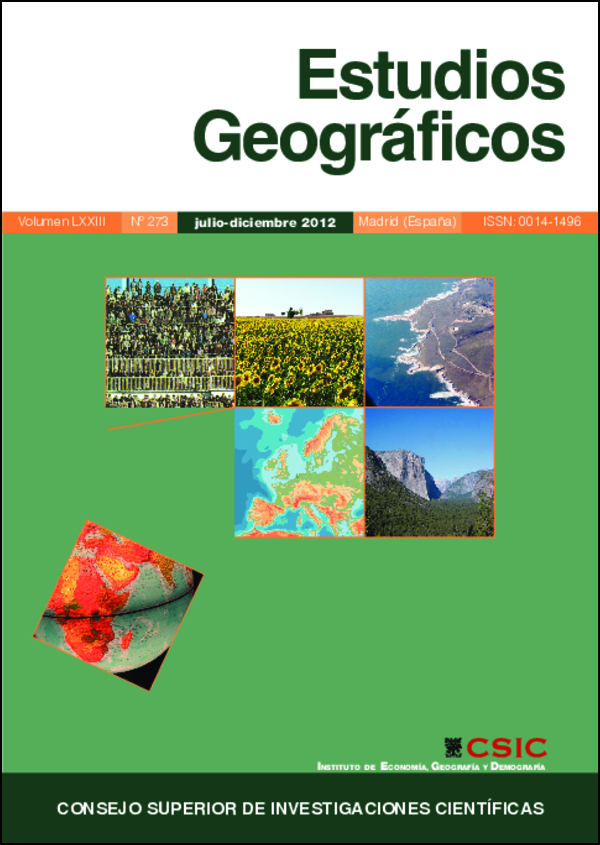The railway maintains its role in the urban evolution of Madrid: the Pasillo Verde and the Chamartín operation
DOI:
https://doi.org/10.3989/estgeogr.201217Keywords:
railway, railway stations, Pasillo Verde, Chamartín Operation, rail linksAbstract
The railway has been a key element in Madrid’s development. It did away with its isolation as a city in the center of a country without navigable waterways and a poor road network. It boosted industrial activity, by making it possible to easily commodities. It was also the reason behind the location that activity, which was tied to the railway stations and railways. It has always influenced the shape of the urban structure; key to the realization of the first urban expansion plan. The railway stations have affected the environment, creating districts marked by the railway business and attracting other activities, transforming urban planning, promoting growth in some cases and slowing it down in others. They have created areas of relationship and activity within the city. In recent years, the disappearance and transformation of the rail infrastructure has generated new urban spaces of great interest, with several unparalleled urban operations.
Downloads
References
Aguilar, I. et al. (1980): Las estaciones ferroviarias de Madrid. Su arquitectura e incidencia en el desarrollo de la ciudad. Madrid, Colegio Oficial de Arquitectos de Madrid, 249 pp.
Álvarez Mora, A. et al. (1980): “El desarrollo histórico de la zona Sur de Madrid”, en I. Aguilar Civera (ed.): Las estaciones ferroviarias de Madrid, Madrid, Colegio Oficial de Arquitectos de Madrid, pp. 148-205.
Ayllón, M. (1997): “El Pasillo Verde Ferroviario de Madrid. Balance del consorcio urbanístico 1989-1997”. Revista de Urbanismo, 192/nov-dic, pp. 12-25.
Ayuntamiento de Madrid (1926): Plan General de Extensión. Madrid, Imprenta Municipal.
Ayuntamiento de Madrid (1929): Información sobre la ciudad. Madrid, Imprenta y Litografía Municipal e Instituto Geográfico y Catastral, 192 pp.
Ayuntamiento de Madrid (1982): Recuperar Madrid. Madrid, Oficina Municipal del Plan, 207 pp.
Ayuntamiento de Madrid (1989): “Pasillo verde ferroviario”, en Ayuntamiento de Madrid (ed.): IV premios de urbanismo, arquitectura y obra pública. Madrid, Ayuntamiento de Madrid, pp. 17-33.
Colegio Oficial de Arquitectos de Madrid (COAM) (1978): Plan Castro. Edición facsímil de la memoria explicativa del plan, con un estudio preliminar de A. Bonet. Madrid, COAM.
De Miguel, C. y Aguilar Civera, I. (1980): Las estaciones ferroviarias de Madrid. Madrid, Colegio Oficial de Arquitectos de Madrid.
Consorcio Urbanístico Pasillo Verde Ferroviario (1994): Operaciones urbanísticas en el entorno ferroviario. El pasillo verde ferroviario.
COPLACO (1981): Los Planes de Ordenación Urbana de Madrid. Madrid, Ministerio de Obras Públicas, 54 pp.
Esteve, J. P. y Bravo, A. (2006): El ferrocarril en Madrid. Madrid, Ediciones La Librería.
González Yanci, Mª. P. (1977): Los accesos ferroviarios a Madrid, su impacto en la geografía urbana de la ciudad. Madrid, Instituto de Estudios Madrileños, 21, 521 pp.
González Yanci, Mª. P. (1999): El Plan de Enlaces Ferroviarios de Madrid en la Segunda República. Madrid, Aula de Cultura, Ayuntamiento de Madrid e Instituto de Estudios Madrileños, 51 pp.
Madoz, P. (1848): Diccionario enciclopédico y estadístico de España y sus posesiones de ultramar. Madrid, Establecimiento tipográfico de Pascual Madoz y L. Sagasti.
Pardo, C. (2004): Vaciado industrial y nuevo paisaje urbano de Madrid. Madrid, La Librería.
Downloads
Published
How to Cite
Issue
Section
License
Copyright (c) 2012 Consejo Superior de Investigaciones Científicas (CSIC)

This work is licensed under a Creative Commons Attribution 4.0 International License.
© CSIC. Manuscripts published in both the print and online versions of this journal are the property of the Consejo Superior de Investigaciones Científicas, and quoting this source is a requirement for any partial or full reproduction.
All contents of this electronic edition, except where otherwise noted, are distributed under a Creative Commons Attribution 4.0 International (CC BY 4.0) licence. You may read the basic information and the legal text of the licence. The indication of the CC BY 4.0 licence must be expressly stated in this way when necessary.
Self-archiving in repositories, personal webpages or similar, of any version other than the final version of the work produced by the publisher, is not allowed.















